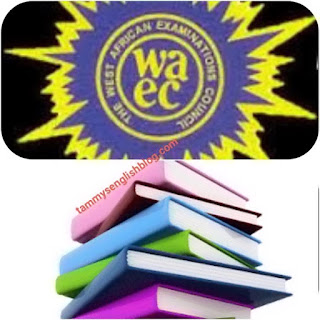The Senior Secondary Certificate Syllabus on English Language is a rigorous one. The English Language teachers have to be very careful in dealing with topics, and they have to work tirelessly so that they can cover the SSCE English syllabus.

The paper on the English Language at the West African Examinations Council and National Examinations Council is divided into three parts. Paper One, Paper Two and Paper Three. There are certain topics that the English teacher must cover before the students can excel in the English Language at the Examinations, that is SSCE English syllabus.
This article has viewed the problem that both teachers and students are facing in which areas to cover so that they can understand the questions. This also proffers a solution to this problem by working on what to teach the students and studying for the examinations to excel. Read the related posts on our education page of the site. It deals with the SSCE English syllabus.
Part One: General Rudiments: Composition and Paragraphs
You will treat the following rudiments before any other topics.
- The concept of composition essay and letter writing
- Paragraphs and paragraphing
- Organising paragraphs and developmental paragraphs
General Rudiments: Composition
- Define the concept of composition
- Discuss the structure of the composition
- Explain the criteria considered by the examiners in awarding marks for letters and essays.
General Rudiment: Paragraphs
- Explain paragraphs
- Distinguish between paragraphs and paragraphing
- Illustrate organising paragraphs (such as Introductory, Transitional and Concluding)
- Illustrate developmental paragraphs (such as Explanatory, Defining, Narrative, Descriptive, Argumentative, discursive, etc.)
Part Two: Essays and Letters
You will discuss the following concepts extensively with copious examples.
- Narrative Essay
- Report Writing
- Descriptive Essay
- Argumentative Essay
- Speech Writing
- Expository Essay
- Article Writing
- Informal Letter
- Semi-formal Letter
- Formal Letter
Narrative Essay
- Define a narrative essay.
- Discuss possible narrative questions (direct, proverbial, idiomatic, etc.c)
- Highlight the characteristics of a good narrative essay
- Outline essential tips to note in a narrative essay
- Illustrate the steps of a narrative essay
- Give a good format for a narrative essay
- Write a good narrative essay and give the students ample exercises to do.
Report Writing
- Define the report.
- Distinguish between a narrative essay and report writing through categories of questions and convincing explanations.
- Describe the steps/processes of report writing.
- Write a good format for report writing.
- Write a good report and give the students ample exercises to do.
Descriptive essay
- Explain the concept of a descriptive essay.
- Classify a descriptive essay into three types (person, town, object/thing/event)
- Illustrate the processes/steps of the descriptive essay.
- Write the format for a descriptive essay.
- Write a good descriptive essay and give the students copious exercises on each type.
Argumentative Essay
- Define an argumentative essay.
- Itemise the types/forms of argumentative essays.
- Outline the qualities of an argumentative essay.
- Illustrate the steps/processes of an argumentative essay.
- Describe a good format for an argumentative essay.
- Write a good argumentative essay and give the students copious exercises to do.
Speech Writing
- Define speech and speech writing.
- Distinguish between a speech and a debate.
- Illustrate the steps/processes of writing a good speech.
- Describe the format for writing a good speech.
- Write a good speech and give the students enough exercises to do.
Expository Essay
- Define the concept of expository essays.
- Highlight essential tips to note in expository essays.
- Illustrate the steps/processes to follow in an expository essay.
- Write a good expository essay and give the students enough exercises.
Article Writing
- Explain the concept of article writing.
- Discuss the rudiments of article writing.
- Illustrate the steps/processes to follow in article writing.
- Describe the format for writing a good article.
- Write a good article on the recent topic and give the students relevant exercises.
Informal Letters
- Explain the concept of an informal letter.
- Highlight the essential facts to note in an informal letter.
- Illustrate the steps/processes of informal letters.
- Describe the format for informal letters.
- Write a good informal letter and give the students relevant exercises to do.
Formal Letters
- Explain the concept of formal letters.
- Itemise and explain the types of formal letters.
- Describe essential facts noticed in formal letters.
- Illustrate the steps/processes of formal letters.
- Describe a good format for writing a formal letter.
- Write a good format letter and give the students several exercises on each type of formal letter.
Part Three: Comprehension and Summary
The following must be treated under comprehension and summary.
- The Concept of Comprehension
- The essential tips and question types are under comprehension passages.
- Tackling comprehension passages.
- Examiner’s comments and model answers to questions in comprehension passages.
- The concept of summary
- Dos and don’ts in summary writing
- Examiner’s comments and model questions in summary writing.
- Give the students copious exercises to do.
Part Three: Comprehension and Reading Comprehension
- Define the concept of comprehension.
- Distinguish between comprehension and reading comprehension.
- Highlight essential hints in answering comprehension passages.
- Discuss the types of questions under comprehension passages.
- Read and answer the comprehension passages.
- Give the examiner’s comments and model answers to various passages.
- Answer any comprehension passage correctly, and give the students ample exercises to do.
- Give the students copious exercises to do.
Part three: Summary writing
- Explain the concept of summary writing.
- Discuss the dos and don’ts of summary writing.
- Discuss the ways of writing a summary.
- Learn from the examiner’s comments and model answers for summarising passages.
- Answer any summary passage correctly, and give the students ample exercises to do.
- Give the students copious exercises to do.
Part Four: Lexis and Structure
You should treat the following subject coverage under the Lexis and structure.
- The concept of lexis
- Elements of lexis (Vocabulary)
- Registers
- Antonyms, synonyms, homonyms, and homophones
- Spellings
- Affixation (prefixes and affixes)
- Idioms, proverbs, and phrasal verbs
- Figurative expressions (figures of speech)
- Structure (grammar)
- Phrases, clauses and sentences
- Tenses and conditional sentences
- Concord
- Articles and determiners
- Subjunctive expressions
- Tag questions
- Active and passive voices
- Parts of speech
- Punctuation marks
Lexis and registers
- Define the concept of lexis (vocabulary) and registers.
- Items are some elements of lexis (vocabulary)
- Explain the concept of registers.
- Illustrate different types of registers.
- Give the students copious exercises to do.
Antonyms, synonyms, homonyms and homophones
- Define antonyms, synonyms, homonyms and homophones.
- Illustrate the examples of each of them extensively.
- Use examples of each word’s meaning in sentences.
- Give the students copious exercises to do.
Idioms, proverbs, phrasal verbs and figurative expressions
- Define idioms, proverbs, and phrasal verbs
- Illustrate the examples of each of them extensively.
- Use examples of each word’s meaning in sentences.
- Give the students copious exercises to do.
Structure (grammar)
- Define phrases, clauses and sentences.
- Discuss the characteristics of each of them.
- Discuss the functions of each of them extensively.
- Work on the grammatical names and functions of each of them.
- Give the students copious exercises to do.
English Tenses and Concord
- Define the concept of tenses.
- Illustrate different aspects of tense.
- Discuss tenses in conditional sentences.
- Explain the concept of concord.
- Explain some rules of concord with relevant illustrations.
- Give the students copious exercises to do.
Articles and determiners
- Define the concept of articles in grammar.
- Illustrate some rules governing the usage of articles in grammar.
- Define the concept of determiners.
- Discuss determiners functioning as pre-modifiers.
- Give the students copious exercises to do.
Subjunctive Expressions and Tag Questions
- Define subjunctives
- Explain subjunctive expressions with examples.
- Define tag questions.
- Illustrate the process of forming tag questions.
- Give the students copious exercises to do.
Active and Passive Voices
- Define voice in grammar and mention its types.
- Explain the active voice.
- Explain with illustrations the active voice.
- Explain passive voice.
- Explain with an illustration the passive voice.
- Discuss the process of forming passive sentences from active sentences.
- Give the students copious exercises to do.
Parts of speech
- Explain parts of speech.
- Explain the types of each of the seven parts of speech.
- Discuss the rudiments of each part of speech.
- Give the students copious exercises to do.
Plural formation and Punctuation marks
- Explain the plural formation in nouns.
- Discuss different rules guiding the formation of plurals from the singulars.
- Discuss the uses of plurals in the context.
- Explain punctuation marks.
- Discuss and illustrate the sectional uses of punctuation marks.
- Give the student enough exercises to do.
Part Five: Oral English
You have to treat the following topics in oral tests. The coverage is as follows:
- Introduction to English sounds
- Branch of English sounds
- Vowels and consonants
- Silent letters
- Important things to note
- Consonant clusters
- Syllables and stress
- Contrastive/emphatic stress
- Minimal pairs and rhymes
- Intonation
Introduction and Branch of English Sounds
- Explain briefly the concept of English sounds.
- Draw the branch of the English sound.
English sound: Vowels
- Explain the concept of vowels.
- Illustrate the production of vowel sounds.
- Provide the correct words for each sound and how to pronounce them correctly.
- Give ample exercises.
English sound: Consonants
- Explain the concept of consonants
- Illustrate the production of consonants
- Provide the correct words for each sound and how to pronounce them correctly.
- Give ample exercises.
Silent Letters
- Explain the meaning of silent letters.
- Provide copious examples of silent letters at the initial, medial and final positions.
- Train the students how to locate them in the words.
- Give the students enough exercises.
Syllables and stress
- Define syllables.
- Illustrate the types of syllables and break some words into syllables.
- Define stress.
- Illustrate the types of stress and place stress on appropriate syllables.
- Give the students enough exercises to do.
Contrastive/Emphatic stress/intonation
- Explain the concept of contrastive stress with relevant examples.
- Discuss minimal pairs with relevant examples.
- Define intonation.
- Explain basic types of intonation.
- Illustrate the uses of rising and falling tunes.
- Give the students enough exercises to do.









